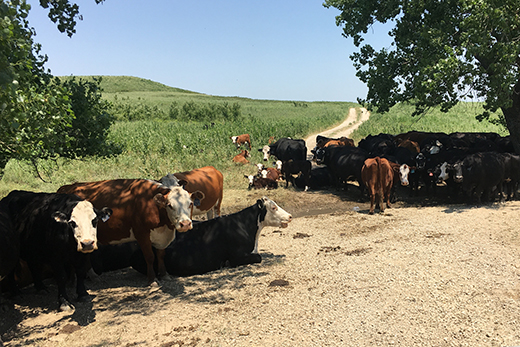MANHATTAN, Kan. — Imagine cattle ranching without traditional fencing and the costly, time-consuming fencing repairs. Two Kansas State University ecologists are working to make that vision a reality while benefiting streams and birds. It’s part of a multi-partner research project using virtual electronic cattle fencing in the Flint Hills of Kansas.
Virtual fencing is accomplished through special cattle collars and advanced GPS tracking that can be used to create exclusion areas or to move cattle without the need for physical fence lines.
The Nature Conservancy is partnering with Kansas State University, National Park Service, Kansas Grazing Lands Coalition and private producers to determine if virtual fencing can help managers improve conservation, business and soil carbon outcomes on working cattle ranches in the United States. K-State received a $435,000 grant from The Nature Conservancy to study the conservation aspects of the project in Kansas.
This work by K-State is part of a $2 million project at three sites that is also assessing how soil carbon and ranching outcomes may be improved with innovative management options made possible by virtual fencing. Additional project sites are located in Colorado and New Mexico.
The Flint Hills is home to some of the last remaining tallgrass prairie in the U.S. During the five-year study, Alice Boyle, associate professor of biology, and Walter Dodds, university distinguished professor of biology, will serve as the K-State co-principal investigators. They are seeking to understand how grazing practices created by virtual fencing affect vegetation, watersheds and grassland birds on the Tallgrass Prairie National Preserve and the neighboring Mushrush Red Angus ranch near Strong City.
The experiments will allow Boyle to assess the impacts of virtual fencing on the habitat of grassland-dependent birds, including the greater prairie chicken and the Henslow sparrow. Dodds will study the effects on riparian zones — the areas bordering bodies of water — and water quality.
“It’s a great opportunity for us to test how to use virtual fencing to protect the waterways in the Flint Hills,” Dodds said. “With the management concerns of the tallgrass prairie and the Flint Hills, both ranchers and researchers are looking at how to align the goals of conservation and cattle production.”
Cattle grazing mimics the original grazing of bison, which is an important part of the prairie ecosystem. Grazing helps to create the habitat patches tallgrass birds need and is also a land management tool. This project will help uncover potential new conservation and land management practices by precisely controlling cattle movement, according to researchers.
“Grazers are really an important part of the system,” Boyle said. “Many of the grassland birds need the cattle. It’s all in the details — the amounts, the locations and the times. This project is going to be a huge advance to be able to manage within pastures at fine spatial scales to achieve the vegetation structure the birds need.”
The Nature Conservancy strives to advance the use of land management tools and practices that improve prairie habitats and to support the adoption of best practices by ranchers, resource professionals and other land managers.

“In the area of the Tallgrass Prairie National Preserve where we will use the virtual fence, we are not able to use a full three-year patch burn grazing rotation,” said Anthony Capizzo, Flint Hills initiative manager with The Nature Conservancy. “This project has the potential to increase habitat diversity types to create a more complex prairie with positive effects on ranching management and economic viability.”
Mushrush Red Angus, a private ranch owned by Daniel Mushrush, adjoins the preserve and is a partner in the research project. Mushrush is looking to support The Nature Conservancy’s conversation goals but also to ensure his business thrives.
“We are using 21st-century technology to solve more than one problem at a time,” Mushrush said. “By using these collars on both sides of the property lines, we protect prairie chicken leks and riparian zones and at the same time, we are grazing more efficiently and intelligently.”
— Michelle Geering, K-State News









